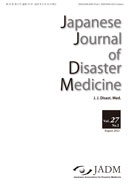When urgently dispatched to a disaster scene, information of the scene are often ambiguous. Therefore, it is critical to accurately grasp the disaster situation and take action. In this case, we experienced medical management at a fire scene, in which limited information was provided beforehand. One Sunday in March, at midnight, there was a request to dispatch a doctor car due to a residential fire accident. We were told that one person had been rescued, however, some might still be left behind. We held a short briefing in four minutes before arriving at the fire scene. After arrival, the on-site command post requested treatment and transportation of two rescued casualties with suspected airway injury. After initial examination and confirmation that their respiratory condition was stable, we had to decide whether to transport them into the emergency room or to stay at the scene for expedient treatment of left-behind casualties. We decided to continue medical management at the site for a maximum of 15 minutes while arranging to convene additional emergency physicians into the hospital. 10 minutes later, we succeeded in gathering additional staff and was able to focus on the medical activity. We confirmed two deaths and treated 19 additional casualties rescued from the scene, returning to the hospital one hour later. In this case, we experienced many difficulties, including the limited time of briefing before arrival, gathering information on the scene after arrival, deciding whether to stay or to leave the scene for optimal management, communicating with the other stuff and the commander, and providing medical treatment. We present this case to increase awareness of the difficulties in the rapid decision-making at the fire scene.
View full abstract
